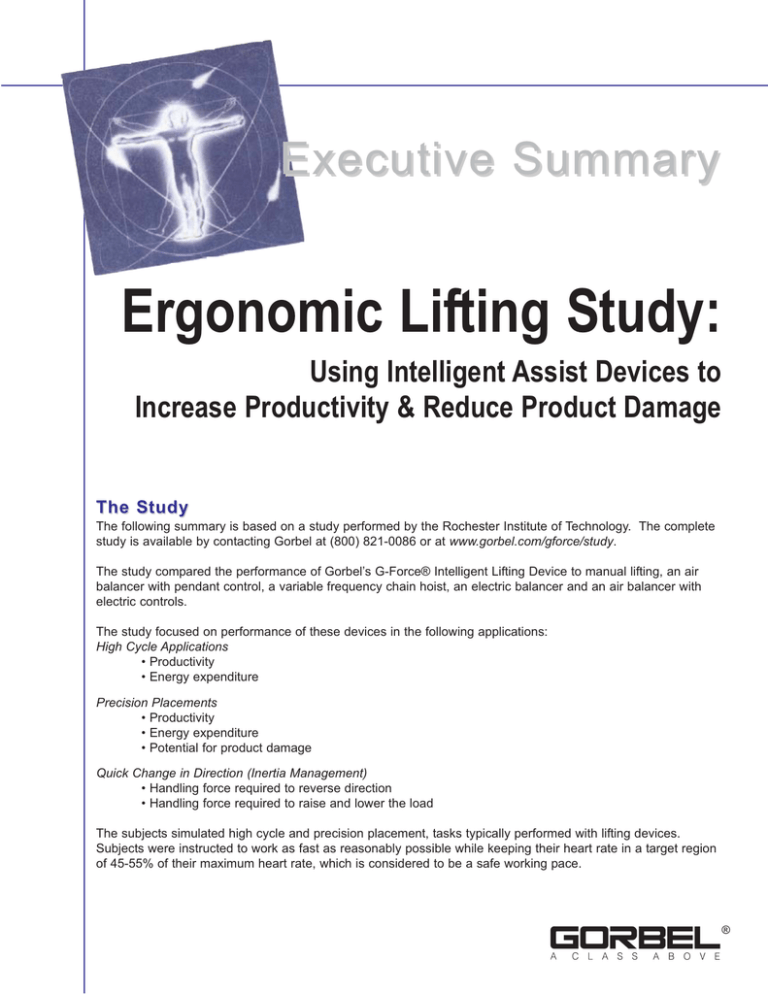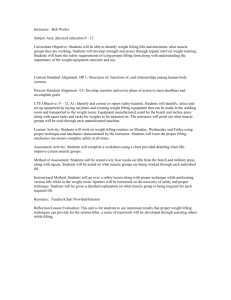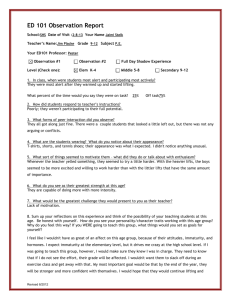
Executive Summary
Ergonomic Lifting Study:
Using Intelligent Assist Devices to
Increase Productivity & Reduce Product Damage
The S tudy
The following summary is based on a study performed by the Rochester Institute of Technology. The complete
study is available by contacting Gorbel at (800) 821-0086 or at www.gorbel.com/gforce/study.
The study compared the performance of Gorbel’s G-Force® Intelligent Lifting Device to manual lifting, an air
balancer with pendant control, a variable frequency chain hoist, an electric balancer and an air balancer with
electric controls.
The study focused on performance of these devices in the following applications:
High Cycle Applications
• Productivity
• Energy expenditure
Precision Placements
• Productivity
• Energy expenditure
• Potential for product damage
Quick Change in Direction (Inertia Management)
• Handling force required to reverse direction
• Handling force required to raise and lower the load
The subjects simulated high cycle and precision placement, tasks typically performed with lifting devices.
Subjects were instructed to work as fast as reasonably possible while keeping their heart rate in a target region
of 45-55% of their maximum heart rate, which is considered to be a safe working pace.
®
2
High Cycle Test
To test each lifting device in a high cycle application, a typical palletizing application that one might find in a warehouse or factory was simulated. Each subject lifted a 45 lb. weight from one position to a position 3’ away as many
times as they could in a ten minute period.
This palletizing application was studied to show the workload associated with repeated manual lifting and to illustrate
the extent to which different lifting devices could increase the number of lifts possible while maintaining the energy
expended (in order to stay within safe ergonomic lifting parameters).
Productivity
Figure 1: Number of Palletizing Lifts shows the
average number of lifts attained with each device
while maintaining a constant work load. Subjects
wore a heart rate monitor to insure they were
working within a safe and comfortable range of
45-55% of their maximum heart rate.1
Figure 1: Number of Palletizing Lifts
(Normalized for Energy Expenditure)
40
35
30
25
39%
fewer
lifts
20
The numbers in blue on Figure 1 show the difference
between the number of lifts achieved with the G-Force®
and the number achieved with each particular lifting
device.
33%
fewer
lifts
15
10
22.6
16.3
10.1
The numbers in blue on Figure 2 show the difference
between the energy expended with the G-Force® and the
energy expended with each particular lifting device.
On average, manual lifting required 78%
more energy than the lifting devices.
13.0
N/A
0
Air
Air
Variable
Gorbel’s Electric
G-Force® Balancer Balancer Balancer Frequency
w/Electric w/Pendant
Chain
Controls
Control
Hoist
Energy Expenditure
Figure 2: Average Energy Expended,
High Cycle Applications
6.0
5.0
6%
more
energy
expended
4.0
METS
Energy was measured through use of a Sensor
Medics system that measured breath by breath
energy expenditure for each subject during lifting.
Energy was measured in Metabolic Equivalents
(METS), which are a measure of how far (as a
multiple) the energy expenditure for a certain
activity exceeds the resting metabolic rate. In
addition to the five lifting devices, subjects
performed manual lifting. Figure 2 shows the
average energy expenditure.
74%
fewer
lifts
17.0
5
Operators were 68% more productive with
G-Force® than with the other methods.
124%
fewer
lifts
75% of the
subjects
could not
complete 10
minutes of
lifting & still
maintain safe
heart rates.
7%
more
energy
expended
8%
more
energy
expended
Manual
78%
more
energy
expended
0.7%
more
energy
expended
3.0
5.08
2.0
2.85
3.01
Gorbel’s
G-Force®
Electric
Balancer
3.06
3.08
2.87
1.0
0
Air
Air
Variable Manual
Balancer Balancer Frequency
w/Electric w/Pendant
Chain
Controls
Control
Hoist
G-Force® required the least amount of
energy among the lifting devices.
High Cycle Conclusions:
• Manual lifting required 78% more energy expenditure than G-Force® and the other lifting
devices.
• Operators were 68% more productive with the G-Force® while exerting approximately the
same energy as the other lifting devices.
1Visit our website at www.gorbel.com/gforce/study for further explanation of this and other components of this study.
3
Precision Placement Test
Many precision placement applications require placing a load as gently as possible to prevent damage to the load. To
simulate this, subjects picked up a 45 lb. weight and placed it on a table top target 3’ away. Underneath the target was
a force plate that measured the force at impact.
Productivity
Figure 3: Number of Precision Placement Lifts
Figure 3: Number of Precision Placement Lifts
shows the average number of lifts attained with
each device while maintaining a constant work
load. Subjects wore a heart rate monitor to insure
they were working within the safe range of 45-55%
of their maximum heart rate.
35
None of the
subjects could
complete 10
minutes of
lifting w/o
exceeding safe
heart rates.
30
25
20
15
The blue numbers in Figure 3 show the difference
between the number of lifts achieved with the G-Force®
and the other lifting methods.
10
41%
fewer
lifts
31%
fewer
lifts
9.9
10.7
59%
fewer
lifts
7.9
8.8
N/A
14.0
5
76%
fewer
lifts
0
Gorbel’s Electric Air Balancer Air Balancer Variable
G-Force® Balancer w/Electric w/Pendant Frequency
Controls
Control Chain Hoist
Operators were 51% more productive with
the G-Force® than with the other products.
Force of Placement
A force measuring system integrated into the
target measured the peak impact force of each
load placement. A damage impact threshold of 1.5
times the weight of the load was computed and
the number of impact forces exceeding that
threshold were counted for each device. The
damage impact threshold for the 45 lb. load used
in the study is 67.5 lbs. Figure 4 shows the
percentage of lifts that exceeded that threshold.
Figure 4: Percentage of Lifts Exceeding Force Threshold
3.3x more likely
to damage the
load
60%
50%
2x more
likely to
damage the
load
40%
30%
2.5x more
likely to
damage
the load
1.7x more
likely to
damage the
load
20%
2.2x more
likely to damage the load
60.2%
37.8%
34.4%
31.1%
The blue numbers in Figure 4 show the likelihood of the
other lifting methods to damage the load as compared to
the G-Force®.
10%
15.3%
Gorbel’s Electric Air Balancer Air Balancer Variable Manual
G-Force® Balancer w/Electric w/Pendant Frequency
Controls
Control
Chain Hoist
Energy Expenditure
The blue numbers on Figure 5 show the difference
between the energy expended with G-Force® compared to
each particular lifting device.
26.5%
0
The G-Force® was 2.5 times less likely to
damage the load than the other devices.
Figure 5: Avg. Energy Expended, Precision Placement
70%
more energy
expended
5.0
14%
more
energy
expended
4.0
METS
Energy was measured through use of a Sensor
Medics system that measured breath by breath
energy expenditure for each subject. In addition to
the five lifting devices, subjects performed manual
lifting in this simulation. See Figure 5 for the
results.
Manual
3.0
18%
more
energy
expended
20%
more
energy
expended
1.26%
less
energy
expended
4.10
2.0
1.0
2.41
2.75
2.85
2.88
2.38
0
Manual lifting required an average of 70%
more energy than the lifting devices.
Gorbel’s Electric Air Balancer Air Balancer Variable
Manual
G-Force® Balancer w/Electric w/Pendant Frequency
Controls
Control
Chain Hoist
Precision Placement Conclusions:
• Operators were 51% more productive with the G-Force®.
• G-Force® was an average of 2.5 times less likely to damage the load than the other devices.
• Manual lifting required 70% more energy than the lifting devices.
4
Inertia Management Test
The final part of the study measured the handling forces involved in overcoming the inertia required to change the
direction of a load being raised or lowered.
Reversing Load Direction
The force required to change load direction from
down to up and from up to down was measured for
the G-Force®, the electronic balancer and the air
balancer with electric controls. The average force
required to change directions is shown in Figure 6:
Force to Reverse Direction.
The numbers in blue on Figure 6 show the difference
between the force required to reverse direction with the
G-Force® compared to the force required with the other
devices.
Figure 6: Force (in pounds) to Reverse Direction
30
8.6x more
force
required
25
20
31.2
15
10
10.5
5
G-Force® required an average of 5.8 times
less handling force to reverse load direction
than the other devices studied in this test.
2.9x more
force
required
0
3.6
Gorbel’s
G-Force®
Electric
Balancer
Air Balancer with
Electric Controls
Inertia Management Conclusions:
Compared to the electric balancer and air balancer with electric controls, G-Force® required:
• An average of 5.8 times less handling force to reverse load direction
S tudy Conclusions
High Cycle Applications:
• G-Force® and other lifting devices require 78% less energy expenditure than manual lifting. And while maintaining
the same average energy expenditure as the other lifting devices, operators were 68% more productive with
G-Force®.
Precision Placement Applications:
• G-Force® and the other lifting devices require 70% less energy than manual lifting. G-Force® excelled above the
other lifting devices by being 51% more productive and 2.5 times less likely to damage the load.
Inertia Management:
• G-Force® requires the least amount of handling force to reverse load direction - saving your operators from the
damaging physical strain these direction changes can have on their bodies.
For More Information
• For the full 23 page study, call us toll free at (800) 821-0086 (US and Canada) or (585) 924-6262
• To request a free G-Force® color brochure or to arrange a local demonstration, call (800) 821-0086 or (585) 924-6262
Gorbel Inc.
600 Fishers Run
Fishers, NY 14453
Phone: 800-821-0086
Fax: 800-828-1808
E-mail: info@gorbel.com
http://www.gorbel.com
© Gorbel 2006
All Rights Reserved






